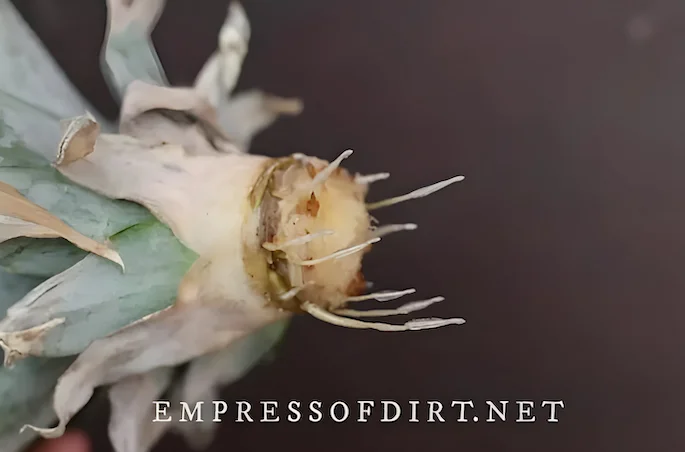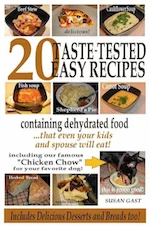- Home
- How To Dehydrate Fruit
- How To Dehydrate Pineapple
How to Dehydrate Pineapple

Susan Gast | Author and blogger at Bored Boomers, Beesville Books, A New Sober You and Easy Food Dehydrating
Discover how to dehydrate pineapple right here, whether it's fresh, or frozen - even canned!

Frequently Asked Questions:
Top question: How to dehydrate pineapple?
Top question: How to dehydrate pineapple?
Keep reading the page you're on for deets on fresh, frozen, and canned pineapple dehydration.
Dried pineapple rings?
Dried pineapple rings?
Simply slice your pineapple into rings, and dehydrate, following the "fresh" instructions further down this page. Pineapple takes anywhere from 6 to 12 hours to dehydrate. Keep on reading for full details on this page.
How do you store pineapple?
How do you store pineapple?
Here's how:
- Whole, uncut pineapple can be stored at room temperature for 2-5 days. Keeping it on the counter allows it to continue ripening.
- For longer shelf life, refrigerate the whole pineapple. It will stay fresh for up to 5-7 days in the fridge.
- Cut pineapple should always be refrigerated in an airtight container. This prevents oxidation and preserves the flavor.
- Cover the exposed pineapple flesh with plastic wrap if not stored in a sealed container. Press the wrap gently against the surface.
- Store cut pineapple chunks in their own juices in the fridge to prevent drying out. Canned pineapple juice works too.
- Frozen pineapple chunks maintain their texture and taste if stored in airtight freezer bags for 2-3 months.
- Dehydrate it first, then store it in food vacuum-sealer bags!
For long-term storage of dehydrated pineapple, use a food vacuum-sealer and pop in an oxygen absorber before drawing out the air. See just how easy it is to dehydrate pineapple, coming up!
Food dehydrator pineapple...
Food dehydrator pineapple...
In answer to that keyword search: Yes! Keep reading to learn how easy it is to dehydrate pineapple using an electric dehydrator from fresh, frozen, or canned pineapple!
Pineapple Nutrition Info.
VITAMINS: Vitamin C and Vitamin B1 (also known as Thiamine).
MINERALS: Potassium, Manganese, Bromelain (digestive enzymes), Copper, and Folate.
Pineapple also packs a punch in the fiber department.
Picking Pineapple at its Peak!

Ready to cut up your pineapple? Read the tips at the end of this page so you know exactly when your pineapple is at its peak!
Carefully cut off the crown and save it! Read the tips from "Empress of Dirt" farther down the page on how to grow your own pineapples, indoors, using the top of the pineapple.
Begin by Using a Good Sharp Knife by Cutluxe!
Check out this great chef's knife with a full tang that means the handle and blade "are one" so they can't come apart when we're slicin' and a dicin'.
I know these Cutluxe Chef knives may be a little expensive, but they do last pretty much a lifetime when you maintain their cutting edges.
As an Amazon Associate, I earn commission from qualifying purchases. The price you pay does not increase. Read disclosure here.
Get a Pineapple Corer!
I have a pineapple corer which you screw into the pineapple and out comes a long coil of pineapple, sliced into approx 1/2" thick overall.
So now we're ready to learn how to dehydrate pineapple!
As an Amazon Associate, I earn commission from qualifying purchases. The price you pay does not increase. Read disclosure here.
How to Dehydrate Pineapple ~ Fresh
- Slice into 1/4" to 1/2" thick "rounds" or chunks, uniformly sized.
- If allergic to Bromelain, follow the instructions below.
- Place the pineapple on your food dehydrator trays.
- Turn on your dehydrator and set the temperature between 125°F and 135°F (or per your food dehydrator's instructions).
💡 Tip: Use our Fahrenheit to Celsius converter here on our site!
This just in from AhtonicusCruxzonicus AKA Papa’s Glorious Beard on Reddit:
Someone was saying that they didn't like the itch from the pineapple and what to do about it?
Here's AhtonicusCruxzonicus' response:
Allergic to Bromelain? Do This:
AhtonicusCruxzonicus says: I core, peel and slice them straight into an ice cold citric acid, honey and salt water bath for about 3 to 5 minutes to perk the flesh up, disrupt the bromelain enzymes that makes them itchy to the mouth, and keep them from turning dark. I also slice them a bit thicker 1/2 or so for a crunchy /chewy mouth experience.
by the way...
That "acidic" sting you are talking about is caused by the Bromelain in the pineapple. Bromelain is an enzyme that eats through the mucous coating on the inside of your mouth, then gets to work on the exposed proteins (which is why it's so good at meat tenderizing.) It’s kind of horrific, but doesn’t cause any permanent damage as long as you don’t continue to eat fresh-pineapple-after-fresh-pineapple like a crazy person without stopping. The enzyme affects some people a more harshly than others, so it’s entirely possible that some will never even notice it at all.
This article from Science Meets Food claims that the dissolved sodium chloride disrupts the enzyme’s polarity, which will “destabilize the protein and denature its structure.” Michael Tunick, Ph.D., an assistant clinical professor of culinary arts and food science at Drexel University in Philadelphia told Food & Wine that salt “triggers bromelain to begin working, so by the time the pineapple reaches your mouth, the enzyme has been inactivated,” and that “dipping fresh pineapple briefly in a saltwater solution is the best way to maximize contact between salt and bromelain.”
- Drying time: between 6-12 hours and up to 18-hours using the above instructions.
- Dehydrated pineapple will feel leathery with no tackiness.
- Remember to rotate your food dehydrator trays, for even drying.
How to Dehydrate Pineapple ~ Frozen
The way to dehydrate frozen (pre-packaged) pineapple, is to simply allow it to thaw in the fridge for 24 hours (or at a minimum overnight).
Drain away excess pineapple juice/ice water in a sieve in the sink.
Follow the "fresh" steps 2 through 3 above, assuming your thawed pineapple has already been cut into uniform pieces.
How to Dehydrate Pineapple ~ Canned
And for canned pineapple? Simply drain the excess pineapple juice from the can as you pour the canned pineapple into a sieve in the sink* and then follow "fresh" steps 2 through 3.
Also, the acidity in pineapple makes it great for tenderizing meats for use in marinades, and for sweet and sour dishes like teriyaki chicken, or pork.
*Many people save the canned juice and enjoy it as a beverage with a bit of sparkling water added to it. Also, use the left-over pineapple juice in your next smoothie!
Rehydrating Dried Pineapple
To rehydrate dehydrated pineapple, simply soak the pineapple - preferably in its own juice - until it plumps back up. Give it about 30 minutes or so.
When using plain water, if you need - or want - to add a little sweetness back in, add a bit of sugar or honey to the water, before rehydrating your dried pineapple.
Enjoy Indoors or Outdoors!

Dehydrated pineapple is much sweeter than fresh pineapple due to the water having been evaporated - it condenses the sweetness.
Don't overindulge in this candy-like fruit snack... I know it's tempting. Having said that, it's a great way to get some energy when you're out hiking in the great outdoors. Take dried pineapple along with you when you're backpacking!
How to Cultivate Pineapple
Here's how to cultivate a pineapple top and grow your own pineapples!
Simply visit empressofdirt.net and learn how to nurture roots to form on a pineapple crown.
Her Empress of Dirt website shares how to grow a pineapple indoors!
Best Areas in the U.S. for Growing Pineapples?
- Hawaii - The tropical climate of Hawaii provides ideal conditions for growing pineapples. The Hawaiian Islands have a long history of pineapple cultivation.
- Florida - Southern Florida's warm climate allows fresh pineapple production, especially along the coasts. Major pineapple growers are located in Palm Beach County.
- Texas - Pineapples are grown in the southernmost and warmest regions of Texas, such as around the Corpus Christi area.
- California - Some specialty and ornamental pineapple growers cultivate pineapples in greenhouses in Southern California.
- Puerto Rico - Puerto Rico has a good tropical climate for pineapple cultivation, especially in the central plains.
- U.S.
Virgin Islands - The hot and humid climate of the Virgin Islands enables
pineapple production. Growers are located on St. Croix Island. Lucky people and pineapples!
The keys to successfully growing pineapples in the U.S. are temperatures above 65°F, high humidity, lots of sunshine, and protection from frost and cold winds. It makes sense, then, that commercial pineapple production thrives best in Hawaii and Florida.
When are Pineapples Ready to Harvest?
- Pineapples are ready to harvest when it has reached full size and maturity. It will be about 16-20 inches tall and weigh 2-4 lbs.
- The skin color changes from green to yellow or orange hues. As the pineapple ripens, the skin color becomes more vibrant.
- The fruit yields a sweet fragrance at the base near the first set of leaves. When lightly pulled, it should release with a bit of resistance.
- The eyes on the pineapple skin are flat, not sunken or concave. The eyes turning concave is a sign of over-ripeness.
- The leaves in the center of the plant begin to turn brown and wilt. But the leaves should still be somewhat firmly attached.
Ideally, pineapples should be harvested when the base turns yellow/orange and the aroma is present - but before over-ripeness sets in - for maximum sweetness and shelf life after picking.
Thanks for visiting how to dehydrate pineapple; check out all our fruit pages here!
Don't forget to grab your free Six Simple Steps eBook! It’s packed with tips for dehydrating everything from fruits and veggies to dog treats. Get it here.
Before You Go...
If you like the content, please give me some love by clicking on the 🩷 in the lower right hand corner (on just about all my pages). This signals to me that you find it enjoyable and useful. Thank you so much!



















